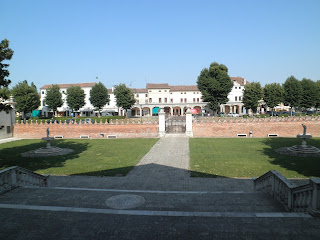Away from the Madding Crowds of Italy (II) - Palladio and Palazzos of Fratta Polesine
 |
| View of Fratta Polesine from Villa Badoer |
The town of Fratta Polesine was not showing its best side, but from the moment we came across the first of the fifteen villas and palazzos that fill this little town, it turned from modern mediocrity to past perfect.
 A rapid procession of palazzos and villas line either side of the once navigable canal that runs through the town but is now home to ducks, dragonflies and low footbridges. The most popular (and frequently visited) of the villas is the Villa Badoer. Commissioned in 1554, and designed by Andrea Palladio, it stands on the site of the ancient castle of Salinguera. Palladio, whose works have been copied across the world, quite prolifically in the UK and USA, only created his buildings in the Veneto region of Italy. They are all listed as UNESCO monuments. The style of temple pediment supported by columns that the Villa Badoer sports is possibly the most recognisable of Palladio's, and Badoer can claim to be the first villa to have such a façade.
A rapid procession of palazzos and villas line either side of the once navigable canal that runs through the town but is now home to ducks, dragonflies and low footbridges. The most popular (and frequently visited) of the villas is the Villa Badoer. Commissioned in 1554, and designed by Andrea Palladio, it stands on the site of the ancient castle of Salinguera. Palladio, whose works have been copied across the world, quite prolifically in the UK and USA, only created his buildings in the Veneto region of Italy. They are all listed as UNESCO monuments. The style of temple pediment supported by columns that the Villa Badoer sports is possibly the most recognisable of Palladio's, and Badoer can claim to be the first villa to have such a façade.The Giallo Fioerntino frescos that decorated the walls of the villa had been covered by plaster and hidden from view for years. Recent restoration work has uncovered them, but sadly in places the damage has been very severe and the artwork can barely be seen.
We had been left to our own devices and wandered around the villa and its grounds at our leisure. We found a modern lecture theatre in one of the basement rooms, and being one who cannot resist opening a door, various stashes of stationery in cupboards. The ground floor also had a couple of interactive touch screens and a building block model, that explained the mechanics of Palladio's constructions. A little more information on the layout of the building would have been good, as it was we moved from room to room deciding amongst ourselves as to what use they could have been put.
In one of the barchessas the National Archaeological Museum has a permanent, and interesting, display. The information had recently been translated into English (very well I might add) which for those of us with poor or non-existent Italian (me) was a god-send.
Many of the villas and palazzos in Fratta Polesine are open at some point during a month, but it would be advisable to check before planning a trip to the town specifically to view the internals of the buildings. Only the Villa Badoer, which was our primary point of call, was open to us, but to wander the sleepy town and admire the architecture is worth while. As you can see from the picture below the buildings of note are all within easy walking distance of each other.
Wandering back to the station, planning our evening (which consisted of shower, food and football - well it was bloody hot and Euro 2012 was in full flow), we congratulated ourselves on a day well spent. Our plans were almost put assunder by the cancellation of our train. As Fratta Polesine is on a small regional line, the trains are far from frequent. Luckily, the timing of the announcement was on our side and by the time we had found the bus stop in the town, and bought tickets, our bus back to Rovigo pulled up. Air-conditioning, comfortable seats and 30 minutes of driving through the Polesine countryside and we were back at our starting point of Rovigo.
.jpg) |
| Waiting for the train that never arrived. |
The Villa Badoer is open on Thursday, Saturday and Sunday from 10am to 12pm and 3.30pm to 6.30pm. Ticket price - €3. The Archaeological Museum is a further €1.50. Tel: 366 3240619. At the time of writing the website for Villa Badoer is under construction.
Fratta Polesine can be reached by bus and train from Rovigo or from the Rovigo Sud exit of the A13.





Comments
Post a Comment